3GPP (3rd Generation Partnership Project) proposed a new architecture of 5G network radio access network (RAN) and core network, which is quite different from LTE network. The re-division and deployment of RAN network functions will affect the architecture of the bearer network. The three major application scenarios of 5G networks have huge differences in network performance requirements, which promote core network slicing and distributed deployment, and also have a greater impact on the architecture and performance of the bearer network.
From the perspective of the bearer network, this article compares the LTE network architecture, analyzes the architecture and deployment characteristics of the 5G network, and puts forward the uncertainties in 5G network equipment and deployment methods, and the impact of these uncertainties on the bearer network.
2 5G network architecture characteristicsWhether it is the RAN part or the core network part, the 5G network architecture is quite different from the LTE network. The following respectively analyzes and compares the LTE and 5G network architectures from the perspective of the bearer network.
2.1 LTE network architecture characteristicsThe LTE RAN network is mainly composed of two network elements, RRU and BBU, as shown in Figure 1:
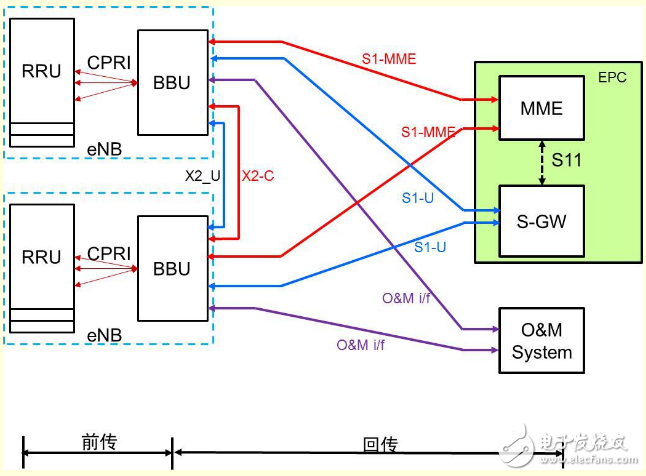
Figure 1 Schematic diagram of LTE network architecture
(1) Each RRU is connected to a BBU, and there is no direct connection between RRUs;
(2) The switch between BBUs can be realized through the core network (EPC) using the S1 interface; it can also be realized through the X2 interface between the BBUs [4]. In the actual LTE network, the handover between base stations is mainly through the S1 interface to simplify the deployment of the network [3].
According to the CPRI interface specification, there are two ways to deploy RAN: 1) Distributed deployment, where BBU and RRU are deployed at the same site, and the fronthaul belongs to intra-station connection; 2) Centralized deployment, where BBU and RRU are deployed at different sites, and the fronthaul belongs to inter-station connection. Both of these methods are widely used.
The LTE core network mainly includes two types of network elements, MME and S-GW, and domestic operators mostly adopt the method of centralized deployment by province.
2.2 5G network architecture characteristicsThe 5G RAN network is mainly composed of three network elements, namely AAU, DU, and CU, as shown in Figure 2:
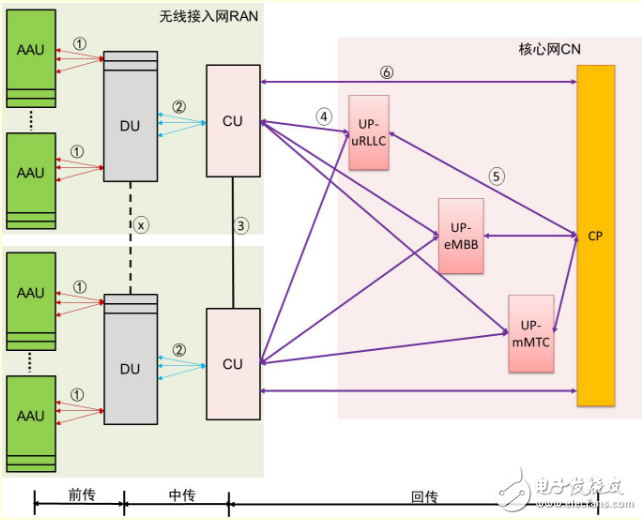
Figure 2 Schematic diagram of 5G network architecture
(1) DU connects multiple AAUs in a star-shaped manner (also called "fronthaul"). There is no direct connection requirement between AAUs, and eCPRI interfaces are used between AAUs and DUs.
(2) CU connects multiple DUs in a star-shaped manner (also known as "intermediate transmission"), there is no direct connection requirement between DUs, and Ethernet interfaces are used between DUs and CUs.
(3) Functions such as handover between base stations are realized through the Xn interface between CUs [7].
There are three main deployment methods for 5G network RAN, as shown in Figure 3:
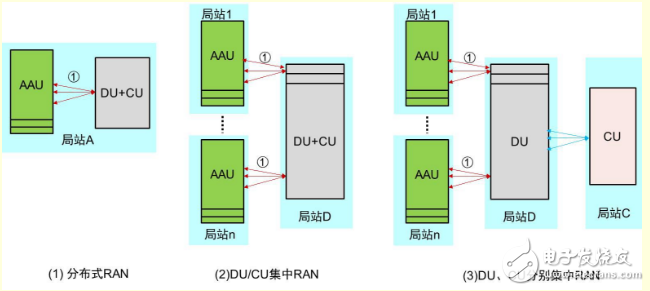
(1) Distributed RAN (2) DU/CU centralized RAN (3) DU and CU centralized RAN
Figure 3 Three deployment methods of 5G RAN
(1) Distributed deployment: AAU, DU, and CU are deployed at the same site, and both fronthaul and midhaul are intra-site connections.
(2) DU/CU centralized deployment: AAU and DU/CU are deployed at different sites, DU/CU are deployed at the same site, fronthaul belongs to inter-station connection, and midhaul belongs to intra-station connection.
(3) DU and CU are separately deployed in a centralized manner: AAU, DU, and CU are all at different sites, and both fronthaul and midhaul are inter-station connections.
The 5G core network mainly includes two types of network elements: control plane (CP) and user plane (UP):
(1) The control plane (CP) adopts cloud-based centralized deployment, and the delay requirement is 10 ms [8], and the traffic is not large. It is relatively possible for domestic operators to choose a centralized deployment by province.
(2) The user plane will adopt the method of slicing deployment according to service characteristics [2], and perform network slicing according to the functions and performance of different types of services, and deploy them separately. Different slices are deployed at different levels of the network.
2.3 Analysis of the main differences between LTE and 5G network architecturesThe main differences between LTE and 5G network architectures are shown in Table 1. Compared with LTE networks, 5G network deployment methods are more diversified, and this diversified deployment method has greater uncertainty for actual network deployment.
Table 1 LTE and 5G network architecture
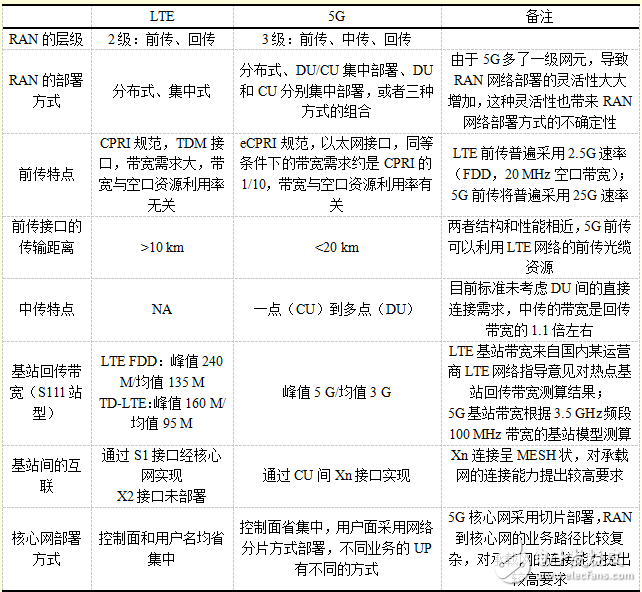
The architecture of the 5G network has been clarified. The typical 5G network deployment structure is shown in Figure 4, but there are still more uncertainties in the implementation of equipment and deployment strategies.
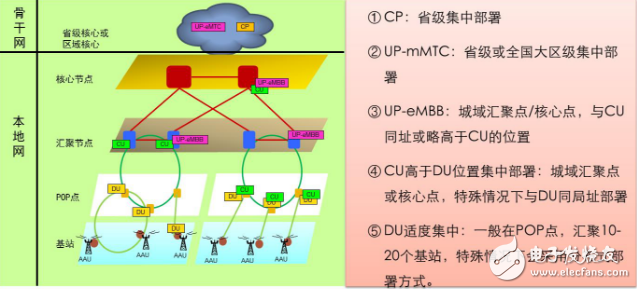
Figure 4 Schematic diagram of 5G network deployment structure
3.1 5G fronthaul requirements are compatible with LTEDomestic operators generally adopt the small-scale centralized deployment of BBUs in the LTE stage. This method greatly reduces network deployment costs, including base station equipment rooms, power supplies, and transmission equipment. It has become the development trend of domestic operators' LTE network construction. In the 5G phase, operators will continue to adopt the method of centralized deployment of DU.
The fronthaul distance defined by the CPRI interface specification is not less than 10 km [5]. The eCPRI network specification [6] does not specify the target distance of the fronthaul, but defines that the one-way transmission delay of the fronthaul should be less than 100 μs, which translates into a transmission distance on the optical fiber that should be less than 20 km. The target distances of the two are relatively close. Domestic operators often adopt the small-scale centralized deployment of BBUs in the LTE stage, and the distance between BBU and RRU is generally less than 10 km. When the 5G network adopts the methods (2) and (3) shown in Fig. 3 for DU centralized deployment, the site location of the DU concentration is the same as the site location of the LTE BBU concentration, and the existing LTE fronthaul optical cable network can be used. The fronthaul distance is less than 10 km, and the more mature 10 km standard 25 Gbit/s optical interface can be used, and the network cost is relatively low.
However, the 5G network operating frequencies determined by the Ministry of Industry and Information Technology are 3.3 GHz—3.6 GHz and 4.8 GHz—5.0 GHz frequency bands [9], which are much higher than the 2.1 GHz/2.6 GHz frequency bands of LTE. Therefore, the density of 5G base stations is expected to be 1.5 times that of LTE base stations. What kind of deployment strategy operators adopt during the 5G deployment period (hot spot deployment, regional continuous coverage, etc.) will have a greater impact on the fronthaul fiber optic cable network. If continuous coverage deployment is adopted, operators need to build a large number of base stations to access fiber optic cables. .
3.2 Uncertainty of CU/DU separate deployment3GPP has proposed a separate functional architecture of CU/DU. Operators also hope that CU can be deployed at a higher level (such as the convergence node of the local network, or even the core node), simplify the organization of collaboration between base stations, improve the efficiency of collaboration, and realize CU and Decoupling of DU.
Currently, equipment suppliers cannot provide commercialized CU and DU equipment. Whether CU and DU can be deployed separately, the capacity and capabilities of the equipment are uncertain.
Whether CU and DU can be deployed separately will affect whether there is an intermediate transmission section on the bearer network, and the number of connections between base stations will be hundreds of times different, which will have a greater impact on the structure and routing capabilities of the bearer network. For example, the number of convergence nodes in a typical city is about 30, and the number of POPs is about 300. If the CU is deployed at the aggregation node, the connection between the DU and the CU is an aggregation connection, and the connection between the CUs is a distributed connection. The number of connections required for a full mesh connection between CUs is 435. The IP network is used at the core aggregation layer of the local bearer network. Technology, this connection is relatively easy to meet. If the CU is deployed at a POP point, the number of CU distributed connections between all POP points will reach 45,000; if each base station is separately deployed with the CU function, the number of connections between CUs will be even greater. This will require that the edge layer of the local bearer network must also adopt IP network technology and have strong routing capabilities.
Therefore, from the perspective of the bearer network, centralized deployment of CUs is also supported. According to the network structure characteristics of the above-mentioned typical cities, the average number of base stations converged at each convergence point is between 100 and 200, and the number of base stations that the CU can carry should be about 200.
3.3 Uncertainty of DUThe 5G network standard puts forward the goal of DU equipment pool grouping. Operators hope to adopt the method of DU pool grouping and centralized deployment to converge the services from multiple base stations and transmit them to the CU. This can greatly improve the efficiency of DU. Facilitate the deployment of coordinated strategies between base stations. However, it is not clear whether DU devices can be pooled. Currently, the DU devices that manufacturers can provide are basically one DU per base station. Even if the DUs are grouped together, it is a stack of multiple DU devices and cannot share baseband resources. Whether the DU is pooled or not will have a greater impact on the choice of China Transmission’s technical solutions:
(1) The number of base stations that the pooled DU can carry: The operator hopes that a DU pool of a POP point can bring all the base stations covered by the POP point. According to the typical urban POP point distribution in section 3.2, the average number of base stations for each POP point is The number of base stations is between 10-20 (30-60 AAU), so the DU pool should be able to carry about 20 base stations, or it can be divided into multiple levels (such as 5, 10, and 20 three levels), according to different POP points Coverage, choose a different DU pool. But now only a few manufacturers have the roadmap of pooled DU products, and the industry has not yet reached a consensus on the capacity target of pooled DU.
(2) The rate and quantity of the DU transmission interface: If the DU can be pooled, a DU pool with 20 base stations only needs two 25 Gbit/s transmission interfaces, and the services from multiple base stations are aggregated and converged. Unified transmission to the CU, the final bandwidth utilization of each intermediate transmission interface can reach more than 60%. If DUs cannot be pooled, each DU can only carry a few AAUs (3~6), and each DU needs at least one 10 Gbit/s intermediate transmission interface, and the final bandwidth utilization rate will be around 30%. This port cannot take advantage of the statistical multiplexing of mid-transmission services to improve bandwidth utilization. The number of DU transfer ports will be 10 times that of the pooled DU, and the cost of the transfer will be much higher than the pooled DU method.
Considering the cost of the bearer network, DU pool grouping is very valuable for bandwidth aggregation and convergence.
3.4 Uncertainty of CUThe size of the CU capacity determines the number of CUs and the location of deployment, and the performance requirements of the bearer network are also greatly different. Section 3.2 proposes that each CU should be able to converge the services of about 200 base stations, but the industry has not yet reached an agreement on the capacity target of the CU, which also brings greater uncertainty to the technical choices and solutions of the bearer network.
If the capacity of the CU can reach about 200 base stations, the CU can be deployed at the aggregation node in a typical city and aggregate the services of all base stations under the aggregation node. The mid-transmission service from DU to CU belongs to a typical point-to-multipoint service model. , You can use a simpler one-layer or two-layer network technology instead of three-layer network technology. If the capacity of the CU is small, in the convergence node of a typical city, multiple CUs need to be deployed to converge the services of all base stations under the sink node. The mid-transmission service from DU to CU belongs to a typical multipoint-to-multipoint business model. It is necessary for the mid-transmission network to support certain three-layer functions, which will increase the construction cost of the mid-transmission network.
3.5 Uncertainty of UP deploymentThe core network UP has been relatively clearly deployed in slices based on different service characteristics, but the location of each slice has not yet been determined. In the early stage of 5G, it was mainly eMBB and mMTC services. The relevant standards of uRLLC have not yet been completed, and the deployment strategy of UP-eRLLC is to be studied.
The one-way delay of eMBB service is less than 10 ms [10], and it is also the largest part of 5G network traffic. Based on the purpose of delay and traffic optimization, UP-eMBB will sink from the provincial centralized mode of LTE to each local network. With the sinking of the CDN network, UP-eMBB will even sink to the convergence layer of the local network. At present, domestic operators have not yet deployed UP-eMBB at the core layer of the local network, and still adopt a clear strategy for the convergence layer. The location of UP-eMBB deployment determines the number of UP nodes and the capacity of a single UP network element. It also affects the location and plan of 5G core network access to the Internet. There are also large differences in the requirements for bearer network performance indicators.
mMTC services are not sensitive to delay, so UP-mMTC will be deployed at a higher level in a centralized manner, such as centralized or regional deployment. The bearer network needs to provide both local and backbone bearer capacity.
4 Recommendations for 5G network deploymentThere are no commercial deployment cases of full-featured 5G networks in the industry. There are large uncertainties in the 5G network architecture, equipment form, and deployment methods. These uncertainties will have a huge impact on the deployment plan and cost of 5G networks. Based on the analysis of some uncertain issues in 5G network deployment, this article puts forward the following suggestions:
(1) The base station should adopt a moderately large-scale centralized deployment method, and make full use of the fronthaul optical cable network resources of the existing LTE network. When 5G is used for continuous coverage, the new base station fronthaul optical cable construction should make full use of the existing optical cable network resources.
(2) DU equipment should support the pool grouping function and be deployed at the existing POP point to improve the efficiency of base station coordination, reduce the cost of the intermediate transmission network, and be able to make full use of the existing network fronthaul and backhaul optical cable network resources. It is recommended that equipment suppliers accelerate the development of DU pool products. The number of base stations that each DU pool can carry should be about 5-20, which can be divided into multiple levels, such as 5, 10, and 20, to meet the needs of different types of POP points.
(3) The separate deployment of CU and DU is the highlight of the 5G network architecture. Deploying CU at the aggregation node can simplify the mid-transmission technical solution, reduce network costs, and can greatly reduce the number of Xn interface connections between base stations and reduce the number of backhaul networks. Performance requirements. According to the analysis of the site layout of typical cities, it is recommended that each CU should be able to converge the services of about 200 base stations.
(4) The user plane of the core network can be deployed in slices. UP-eMBB should be deployed in the metro core as far as possible when the service quality is guaranteed. The concentration of equipment is also conducive to improving resource efficiency and reducing the number of data center computer rooms on the local network. It also reduces the need for the backbone bearer network of the backhaul network.
The changes in the 5G network architecture have the greatest impact on the edge layer of the local bearer network (the network level from the POP point to the convergence point). According to the recommendations of the above network deployment architecture, only the three-layer bearer technology needs to be adopted at the core convergence layer of the local network. The edge layer can be organized by one-layer or two-layer transmission equipment (such as PeOTN, etc.) to reduce network construction and maintenance costs.
With so many uncertainties in the current 5G technology, there are still the following risks for nationwide deployment in 2020:
(1) Some new technologies and functions of 5G network and equipment are difficult to realize in the network;
(2) The cost of adopting these new technologies and supporting these new functions in future network upgrades is relatively high, and the environmental cost is relatively high.
In the 3G and LTE phases, several Chinese operators will deploy after other operators a few years later. The maturity and stability of the equipment are relatively high, the uncertainty is small, and the construction cost is low. Therefore, the operators can be in 2-3 years Basically, a nationwide continuous coverage network has been established. Therefore, if Chinese operators want to lead the world in 5G network deployment, they must consider the above uncertain risk factors. It is recommended to appropriately grasp the pace of 5G deployment to reduce the negative impact of the above risks.
5 concluding remarksThis paper analyzes the characteristics of the 5G network architecture by comparing the LTE and 5G network architectures, and conducts an in-depth analysis of the uncertainties in the current 5G network architecture, deployment methods, and equipment forms, and points out the impact of these uncertainties on the bearer network. Influencing, put forward the development suggestions for these uncertain factors and the corresponding bearing technical plan.
ZGAR bar 2000 Puffs
ZGAR electronic cigarette uses high-tech R&D, food grade disposable pod device and high-quality raw material. All package designs are Original IP. Our designer team is from Hong Kong. We have very high requirements for product quality, flavors taste and packaging design. The E-liquid is imported, materials are food grade, and assembly plant is medical-grade dust-free workshops.
Our products include disposable e-cigarettes, rechargeable e-cigarettes, rechargreable disposable vape pen, and various of flavors of cigarette cartridges. From 600puffs to 5000puffs, ZGAR bar Disposable offer high-tech R&D, E-cigarette improves battery capacity, We offer various of flavors and support customization. And printing designs can be customized. We have our own professional team and competitive quotations for any OEM or ODM works.
We supply OEM rechargeable disposable vape pen,OEM disposable electronic cigarette,ODM disposable vape pen,ODM disposable electronic cigarette,OEM/ODM vape pen e-cigarette,OEM/ODM atomizer device.

ZGAR bar 2000 Puffs Disposable Vape, bar 2000puffs,ZGAR bar 2000 Puffs disposable,ZGAR bar 2000 Puffs,ZGAR bar 2000 Puffs OEM/ODM disposable vape pen atomizer Device E-cig
ZGAR INTERNATIONAL(HK)CO., LIMITED , https://www.sze-cigarette.com
